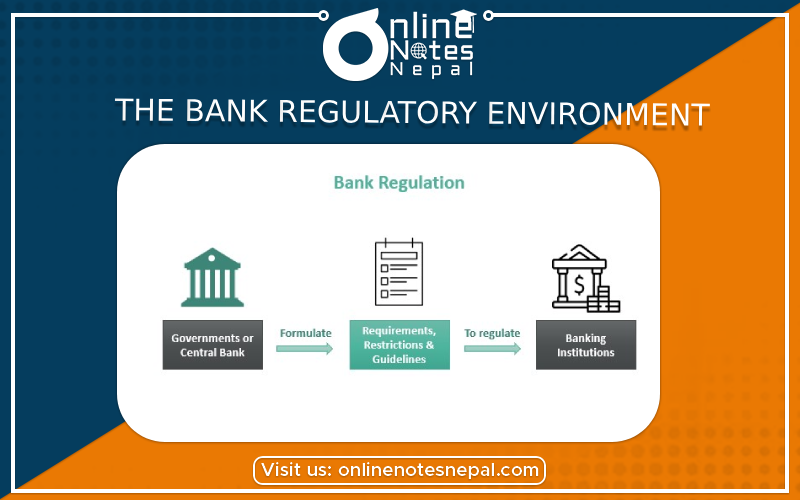Published by: Anu Poudeli
Published date: 16 Jul 2023

The framework of rules, laws, and supervisory practices that control the activities of banks and financial institutions is referred to as the bank regulatory environment. Government authorities enact these policies to safeguard the financial system's stability and integrity, to protect customers, and to limit systemic risks. To handle new difficulties and adapt to changing market conditions, the regulatory landscape is always shifting. The following are some important characteristics of the banking regulatory environment:
1.Basel Accords : The Basel Accords are a set of international accords established by the Basel Committee on Banking Supervision (BCBS) to establish minimum capital requirements for banks. These agreements, particularly Basel III, attempt to strengthen bank resilience by requiring higher capital ratios and stronger risk management processes.
2.Capital Adequacy: Banks are required to keep a specific amount of capital on hand as a reserve against future losses. Capital adequacy ratios, such as the Common Equity Tier 1 (CET1) ratio, are used to assess a bank's capital sufficiency in relation to its risk-weighted assets.
3.Liquidity Requirements : Liquidity requirements ensure that banks have enough liquid assets to satisfy their short-term obligations and resist unforeseen funding challenges. Examples of liquidity requirements include the liquidity coverage ratio (LCR) and the net stable funding ratio (NSFR).
4. Stress Testing : Banks are subjected to frequent stress tests to examine their ability to withstand severe economic conditions and financial shocks. Stress tests assess a bank's capital sufficiency and risk management policies under various fictitious situations.
5.Anti-Money Laundering (AML) and Terrorist Financing (CFT): Banks must have tight procedures to detect and prevent money laundering and terrorist financing. They are required to undertake customer due diligence, report suspicious transactions, and follow know-your-customer (KYC) guidelines.
6.Consumer Protection : Regulations ensure that banks treat their customers fairly and give clear information about their products and services. In the United States, laws such as the Truth in Lending Act (TILA) and the Equal Credit Opportunity Act (ECOA) protect consumers' rights.
7.Dodd-Frank Act to Reform Wall Street and Protect Consumers: This comprehensive law, enacted in reaction to the 2008 financial crisis, sought to improve financial stability, boost transparency, and safeguard consumers. The Consumer Financial Protection Bureau (CFPB) was established to supervise consumer financial protection.
8.Prudential Supervision: Prudential supervision is carried out by banking regulators such as the Federal Reserve, the Office of the Comptroller of the Currency (OCC), and the European Central Bank (ECB) to monitor banks' compliance with regulations and assess their overall financial health.
9. Cyber security and Data protection : With the growing importance of digital banking, laws have been introduced to address cybersecurity threats and protect consumer data from breaches and unauthorized access.
10.Systemically significant Financial Institutions (SIFIs): Due to their potential impact on the broader financial system, large banks and financial institutions designated systemically significant are subject to more strict regulations.
The bank regulatory framework is critical to preserving financial stability and protecting the interests of consumers and investors. It does, however, provide hurdles for banks, as they must traverse complicated and constantly changing regulatory regulations while being competitive and profitable.